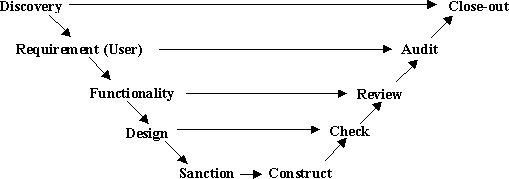The Whole Project and Nothing but the Whole Project
Anyone who has ever worked on a sizeable project knows that the model
above lacks the most nerve-racking, heart breaking and stress-inducing
phase — "Sanction". Sanction, also known as board approval,
capital authorization, etc., deserves a special mention. It is the
effective corporate milestone between Plan and Do, it is both the end of
Planning and the start of Doing, but is beyond the direct control of the
project team.
The definition of "audit" earlier suggests that once the customer is
satisfied the project has finished. Again, real life appears to be
different, usually with documentation to file and archive, training to complete,
invoices to be paid and a myriad of other minor but significant activities.
This clearly implies that there is a technical completion and an administrative
completion to the project that do not coincide.
These two points hint at two further concepts. The first is that the WBS
should have two branches, one based on the technical elements and another
based on the administrative elements, something that is beyond the current
discussion. The second point is that there is an administrative lifecycle
running in tandem with the technical lifecycle.
If the phase of Sanction is inserted between Plan and Do, or Define and
Execute, or Design and Construct with a phase called "Close-out"
added as the final phase the model becomes extremely robust. Thus, the
administrative lifecycle appears from under the technical lifecycle and a
true picture of the project lifecycle emerges. By adding these two steps
the simple two-for-one subdivision is lost, but the reason is clear, there
are administrative processes that run behind the technical timing of the
project. This time lag is a function of the scale and effectiveness of the
communication systems of the project.
The life of a single project can now be given a simple generic third
level model. The elegance of this generic third level is the intrinsic
stage-gate definition that it brings to the project lifecycle. This can be
best be displayed diagrammatically:

Thus, the Planning (sub)phases define the stage-gate criteria for the
corresponding Doing (sub)phases. Design produces the objectives for Check while Discovery sets them
for Close-out. The same principle
applies to the intermediate phases. Thus, each Doing phases becomes an opportunity for the instigating
department of the organization to confirm its intentions in the Planning
phase have been met.
It is worth of noting at this point that the Design phase, and
occasionally the Functionality phase are subdivided according to the number
of levels on the WBS, and hence so are the Review and Audit phases.
As an aside for those from the pharmaceutical industry that read this,
Design Qualification (DQ) is a quality assurance method that does not
apply
across the lifecycle, but measures the design against an "external"
standard. Equally, Process
Validation is more likely to be removed from the Audit phase and become
a project in its own right, with the names of the phase suitably altered.
|



